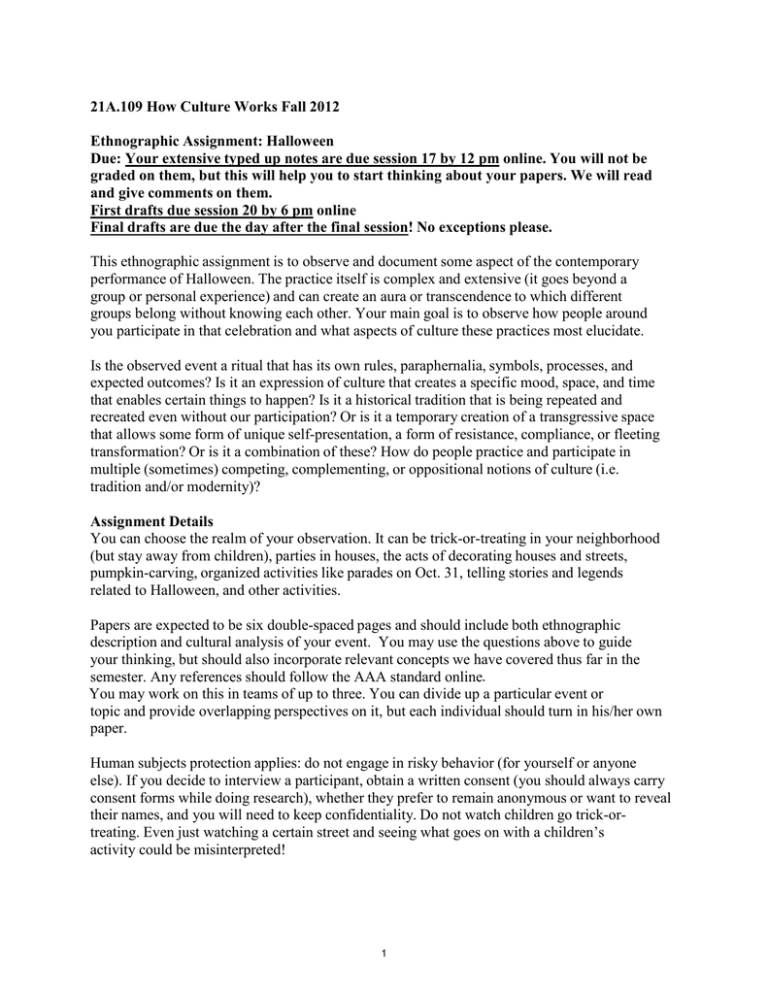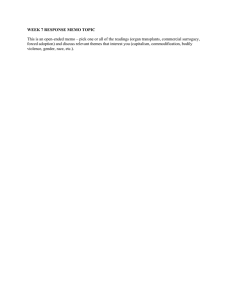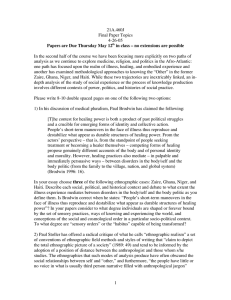Document 13484627
advertisement

21A.109 How Culture Works Fall 2012 Ethnographic Assignment: Halloween Due: Your extensive typed up notes are due session 17 by 12 pm online. You will not be graded on them, but this will help you to start thinking about your papers. We will read and give comments on them. First drafts due session 20 by 6 pm online Final drafts are due the day after the final session! No exceptions please. This ethnographic assignment is to observe and document some aspect of the contemporary performance of Halloween. The practice itself is complex and extensive (it goes beyond a group or personal experience) and can create an aura or transcendence to which different groups belong without knowing each other. Your main goal is to observe how people around you participate in that celebration and what aspects of culture these practices most elucidate. Is the observed event a ritual that has its own rules, paraphernalia, symbols, processes, and expected outcomes? Is it an expression of culture that creates a specific mood, space, and time that enables certain things to happen? Is it a historical tradition that is being repeated and recreated even without our participation? Or is it a temporary creation of a transgressive space that allows some form of unique self-presentation, a form of resistance, compliance, or fleeting transformation? Or is it a combination of these? How do people practice and participate in multiple (sometimes) competing, complementing, or oppositional notions of culture (i.e. tradition and/or modernity)? Assignment Details You can choose the realm of your observation. It can be trick-or-treating in your neighborhood (but stay away from children), parties in houses, the acts of decorating houses and streets, pumpkin-carving, organized activities like parades on Oct. 31, telling stories and legends related to Halloween, and other activities. Papers are expected to be six double-spaced pages and should include both ethnographic description and cultural analysis of your event. You may use the questions above to guide your thinking, but should also incorporate relevant concepts we have covered thus far in the semester. Any references should follow the AAA standard online. You may work on this in teams of up to three. You can divide up a particular event or topic and provide overlapping perspectives on it, but each individual should turn in his/her own paper. Human subjects protection applies: do not engage in risky behavior (for yourself or anyone else). If you decide to interview a participant, obtain a written consent (you should always carry consent forms while doing research), whether they prefer to remain anonymous or want to reveal their names, and you will need to keep confidentiality. Do not watch children go trick-ortreating. Even just watching a certain street and seeing what goes on with a children’s activity could be misinterpreted! 1 Evaluation Criteria ü Does the author explain why he/she chose to observe a particular practice? ü Does he/she ask anthropologically informed questions? ü Does the author describe the event in a clear and detailed way? ü Does the author discuss theoretical issues that stem from the event? ü Does the author offer unique and insightful analysis? ü Does the author thoroughly problematize the aspects that she/he had observed? (instead of merely recounting the event)? ü Does he/she offer multiple and competing interpretations of the event? Do these interpretations appropriately lend themselves to a nuanced discussion of the concept of culture and its various analytical frameworks? ü Is the paper well-written, grammatically and stylistically? Are references properly sourced? 2 MIT OpenCourseWare http://ocw.mit.edu 21A.01 How Culture Works Fall 2012 For information about citing these materials or our Terms of Use, visit: http://ocw.mit.edu/terms.



